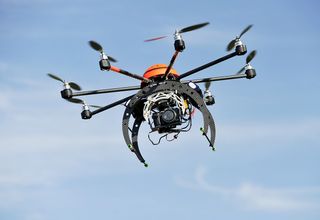
This article was originally published on The Conversation. The publication contributed this article to Live Science's Expert Voices: Op-Ed & Insights.
You will be forgiven if you missed the Drones for Good competition held recently in Dubai. Despite drone technology really taking off commercially in the last year or so (the potential puns are endless) they remain a relatively niche interest.
Drones – or unmanned aerial vehicles (UAVs) as they are increasingly known – have reached a mass-market tipping point. You can buy them on the high street for the price of a smartphone and, despite a large DIY Drone community, the out-of-the-box versions are pretty extraordinary, fitted with built-in cameras and “follow me” technology, where your drone will follow you as you walk, run, surf, or hang-glide. Their usefulness to professional filmmakers has led to the first New York Drone Film Festival to be held in March 2015.
Technologically speaking, drones' abilities have all manner of real-world applications. Some of the highlights from the US$1m prize for the Drones for Good competition include a drone that delivers a life-ring to those in distress in the water. Swiss company Flyability took the international prize for Gimball, a drone whose innovative design allows it to collide into objects without becoming destabilised or hard-to-control, making it useful in rescue missions in difficult areas.
The winner of the national prize was a drone that demonstrates the many emerging uses for drones in conservation. In this case, the Wadi drone can help record and document the diversity of flora and fauna, providing a rapid way to assess changes to the environment.
More civilian uses than military
What does this all mean for how we think about drones in society? It wasn’t long ago that the word “drones” was synonymous with death, destruction, and surveillance. Can we expect us all to have our own personal, wearable drone, as the mini-drone Nixie promises? Of course the technology continues to advance within a military context, where drones – not the kind you can pick up, but large, full-scale aircraft – are serious business. There’s even a space drone, NASA’s Boeing X-37, which spent several years in automated orbit, while others are in development to help explore other planets.
There’s no escaping the fact that drones, like a lot of technology now in the mainstream, have trickled down from their military origins. There are graffiti drones, drone bands, Star Wars-style drone racing competitions using virtual reality interfaces, and even theatrical drone choreography, or beautiful drone sculptures in the sky.
Sign up for the Live Science daily newsletter now
Get the world’s most fascinating discoveries delivered straight to your inbox.
There are a few things about drones that are extremely exciting – and controversial. The autonomous capabilities of drones can be breathtaking – witnessing one just fly off at speed on its own, it feels extremely futuristic. But this is not strictly legal at present due to associated risks.
A pilot must always have “line of sight” of the drone and have the capacity to take control. Technically even the latest drones still require a flight path to be pre-programmed, so the drone isn’t really making autonomous decisions yet, although the new DJI Inspire is pretty close. Drone learning has to be the next step in their evolution.
Yet this prospect of artificial intelligence raises further concerns of control, if a drone could become intelligent enough to take off, fly and get up to all kinds of mischief, and locate a power source to re-charge, all without human intervention or oversight, then where does that leave humanity?
There are also concerns about personal privacy. If Google Glass raised privacy hackles, drones will cause far worse problems. There have already been a few occasions where drones have caused some trouble, such as the one that crashed onto the Whitehouse lawn, or the one that overshot into a runway at London Heathrow. The point at which a drone is involved in something very serious may be the point at which their status as a mainstream toy ends.
This article was originally published on The Conversation. Read the original article. Follow all of the Expert Voices issues and debates — and become part of the discussion — on Facebook, Twitter and Google +. The views expressed are those of the author and do not necessarily reflect the views of the publisher. This version of the article was originally published on Live Science.

